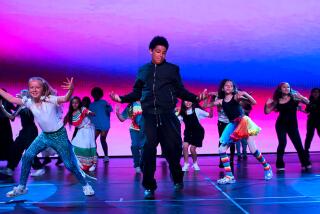B. Harkarvy, 71; Teacher of Dance
Benjamin Harkarvy, an internationally renowned choreographer, dance teacher and company director, has died. He was 71.
Harkarvy, director of the dance division of the Juilliard School in New York, died of heart failure in a Manhattan hospital on Saturday.
In 1982, The Times called him “one of the world’s leading [dance] pedagogues,” and the previous year the Christian Science Monitor had described him as looking like “the enjoyer he is--of dance, music, good food and people--a round man with a shaved head, never mistaken for a dancer, who has taught since the ‘50s.”
The core of his teaching required as much mental as physical adaptability. “I want my dancers flexible and intelligent,” he told The Times in 1974. “I want them to have minds like sponges which absorb, absorb, ABSORB.”
Harkarvy was born in New York City and studied with major ballet teachers and at the School of American Ballet, making his debut as a dancer with the Brooklyn Lyric Opera in the 1949-50 season. He also danced in summer stock and with various concert groups before beginning his teaching career at the Fokine School in New York in 1951.
Writing in Dance magazine in 1974, Tobi Tobias described Harkarvy’s teaching as “quietly knowledgeable, with a personal care and concern for the dancers that never compromises his evidently high standards.”
Harkarvy left Fokine in 1955 to open his own New York school but soon was appointed director and ballet master of Canada’s Royal Winnipeg Ballet (1957-58). After a one-year stint as ballet master of the Netherlands Ballet, he founded what would become one of the world’s great companies, Nederlands Dans Theater, in 1959, serving as its co-artistic director for the next decade and helping give it the contemporary focus and fusion of ballet and modern dance technique that it has sustained ever since.
He also choreographed for the company, for the Joffrey Ballet, the Bat-Dor company of Israel, the Eglevsky Ballet, Les Grands Ballets Canadiens and the companies he later directed.
“As a choreographer, Mr. Harkarvy is fluent, gifted and imaginative,” dance critic Clive Barnes wrote in the New York Times in 1973. “His work has more taste than brilliance, yet that very quality of taste makes it significant in contemporary ballet.”
But success in The Hague eventually inspired him to seek new horizons. “When I knew that [Nederlands Dans Theater] could stand on their own feet,” he told The Times in 1974, “I decided it was time to move on.”
His wanderlust led him to serve as co-artistic director of the New York-based Harkness Ballet (1969-70), as co-director of the Dutch National Ballet (1970-71) and as associate director and then artistic director of the Pennsylvania Ballet from 1972 to 1983.
Forced out during a company financial crisis, he taught and choreographed for a number of companies before joining the Juilliard faculty in 1990. He soon brought the school’s philosophy in line with his concept of contemporary dance.
“Juilliard dancers learn to look at dance as dance, not as modern or ballet,” Harkarvy told Dance magazine two years ago. “They recognize that really great talent has to do with how you move, how fascinating you are. They are, therefore, I feel, being trained for the future.”
Harkarvy is survived by his brother, Jerome C. Golden, of Merrick, N.Y.
More to Read
The biggest entertainment stories
Get our big stories about Hollywood, film, television, music, arts, culture and more right in your inbox as soon as they publish.
You may occasionally receive promotional content from the Los Angeles Times.










